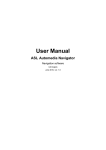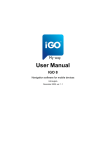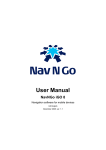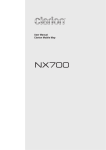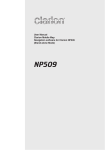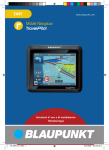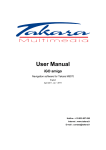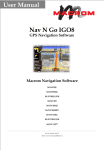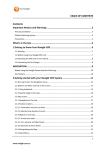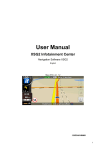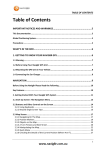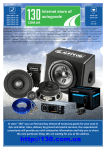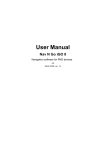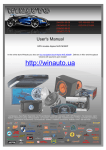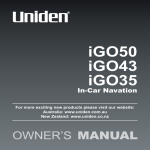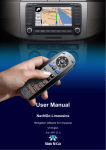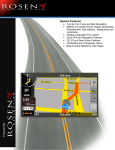Download VE2 Operations Manual (PDF 2140Kb)
Transcript
User Manual ASL Navigator April 2012, ver. 1.0a Copyright note The product and the information contained herein is subject to change without prior notification. This manual may not, in whole or in part, be reproduced or transmitted in any form either electronically or mechanically, including photocopying and recording, without the express written consent of ASL automedia © 2012 – ASL automedia Data Source © 2006 Tele Atlas N.V. Austria: Denmark: France: Great Britain: Italy: Northern Ireland: Norway: Switzerland: The Netherlands: © BEV, GZ 1368/2003 © DAV © IGN France Ordnance Survey data with permission of Her Majesty’s Stationery Office © Crown Copyright © Geonext/DeAgostini © Ordnance Survey of Northern Ireland © Norwegian Mapping Authority, Public Roads Administration / Mapsolutions © Swisstopo Topografische ondergrond Copyright © dienst voor het kadaster en de openbare registers, Apeldorn All rights reserved. 2 Thank you for choosing ASL Navigator as your door-to-door in-car navigator. This document is the detailed description of the software. You can easily discover ASL Navigator while you are using it; however, we still recommend that you read this manual to understand the screens and the features of ASL Navigator. 3 Table of contents 1 Warnings and Safety information .................................................................................. 7 2 Getting started with ASL Navigator .............................................................................. 8 2.1 Buttons and other controls on the screen ............................................................................... 10 2.1.1 Using keyboards............................................................................................................................. 11 2.2 Using the map ......................................................................................................................... 11 2.2.1 Checking the details of a map location .......................................................................................... 11 2.2.2 Manipulating the map .................................................................................................................... 12 2.2.3 Lane information and Signposts .................................................................................................... 15 2.2.4 Status information and hidden controls on the map ....................................................................... 15 2.2.5 Using the Cursor (the selected map location) ................................................................................ 18 2.3 ASL Navigator concepts ......................................................................................................... 19 2.3.1 Smart Zoom ................................................................................................................................... 19 2.3.2 Position markers............................................................................................................................. 19 2.3.2.1 Current GPS position and Lock-on-Road ............................................................................................... 19 2.3.2.2 Returning to normal navigation .............................................................................................................. 20 2.3.2.3 Selected location (Cursor) ...................................................................................................................... 20 2.3.2.4 Original position in the Cursor menu ..................................................................................................... 20 2.3.3 Daytime and nightcolour schemes ................................................................................................. 21 2.3.4 Colour scheme in tunnels ............................................................................................................... 21 2.3.5 Route calculation and recalculation ............................................................................................... 21 2.3.6 Itinerary .......................................................................................................................................... 22 2.3.7 Route demonstration ...................................................................................................................... 23 2.3.8 POI (Points of Interest) .................................................................................................................. 23 2.3.9 Speed limit warning ....................................................................................................................... 23 2.3.10 TMC (Traffic Message Channel) ................................................................................................. 24 3 Navigating with ASL Navigator .................................................................................... 25 3.1 Selecting the destination of a route ........................................................................................ 25 3.1.1 Selecting the Cursor as the destination .......................................................................................... 25 3.1.2 Entering an address or part of an address ....................................................................................... 26 3.1.2.1 Entering an address (Europe) ................................................................................................................. 26 3.1.2.2 Entering an address if house numbering is restarted .............................................................................. 27 3.1.2.3 Entering an address without knowing the district/suburb ....................................................................... 28 3.1.2.4 Selecting an intersection as the destination ............................................................................................ 29 3.1.2.5 Selecting a city centre as the destination ................................................................................................ 30 3.1.2.6 Entering an address with a postal code .................................................................................................. 31 3.1.2.7 Tips on entering addresses quickly ......................................................................................................... 32 3.1.3 Selecting the destination from your Favourites .............................................................................. 32 3.1.4 Selecting the destination from the POIs ......................................................................................... 33 3.1.5 Selecting the destination from the History ..................................................................................... 34 3.1.6 Selecting the destination by entering its coordinates ..................................................................... 34 4 3.2 Creating a multi-point route (inserting a via point) ............................................................... 35 3.3 Creating a multi-point route (appending a new destination) ................................................. 35 3.4 Editing the route ..................................................................................................................... 36 3.5 Watching the simulation of the route ...................................................................................... 36 3.6 Pausing the active route ......................................................................................................... 37 3.7 Deleting the next via point from the route .............................................................................. 37 3.8 Deleting the active route ........................................................................................................ 37 3.9 Saving a route ......................................................................................................................... 38 3.10 Loading a saved route .......................................................................................................... 38 4 Reference Guide ............................................................................................................. 39 4.1 Map screen ............................................................................................................................. 39 4.1.1 Icons on the map ............................................................................................................................ 42 4.1.1.1 GPS position quality indicator................................................................................................................ 42 4.1.1.2 Status indicator strip ............................................................................................................................... 42 4.1.1.3 Next two route events (Turn Preview fields) ........................................................................................... 43 4.1.2 Objects on the map......................................................................................................................... 44 4.1.2.1 Streets and roads .................................................................................................................................... 44 4.1.2.2 3D object types ....................................................................................................................................... 44 4.1.2.3 Elements of the active route .................................................................................................................... 44 4.1.3 Avoid menu.................................................................................................................................... 45 4.1.4 Cursor menu ................................................................................................................................... 46 4.1.5 Position menu ................................................................................................................................ 47 4.1.6 Route Information screen ............................................................................................................... 47 4.1.7 Trip Information screen ................................................................................................................. 48 4.1.7.1 Trip Computer screen ............................................................................................................................. 50 4.1.8 Quick menu .................................................................................................................................... 51 4.1.9 GPS Data screen ............................................................................................................................ 52 4.2 Find menu ............................................................................................................................... 53 4.3 Route menu ............................................................................................................................. 54 4.4 Manage menu ......................................................................................................................... 54 4.4.1 Manage Saved Routes .................................................................................................................... 55 4.4.2 Manage History .............................................................................................................................. 55 4.4.3 Manage POIs.................................................................................................................................. 55 4.4.4 Manage Favourites ......................................................................................................................... 57 4.4.5 User Data Management .................................................................................................................. 57 4.5 Settings menu .......................................................................................................................... 58 4.5.1 Map Screen settings ....................................................................................................................... 59 4.5.2 Navigation settings ......................................................................................................................... 60 4.5.3 Route Planning options .................................................................................................................. 60 4.5.4 Regional settings ............................................................................................................................ 62 4.5.5 Menu settings ................................................................................................................................. 63 5 4.5.6 TMC settings.................................................................................................................................. 63 4.5.7 Warning settings ............................................................................................................................ 64 5 Glossary ........................................................................................................................... 65 6 End User Licence Agreement ........................................................................................ 67 6 1 Warnings and Safety information ASL Navigator is a navigation system that helps you find your way to your destination with its built-in GPS receiver. ASL Navigator does not transmit your GPS position; others cannot track you. It is important that you look at the display only when it is safe to do so. If you are the driver of the vehicle, we recommend that you operate ASL Navigator before you start your journey. Plan the route before your departure and stop if you need to change something in the route. You must obey the traffic signs and follow the road geometry. If you deviate from the route that ASL Navigator recommended, ASL Navigator changes the instructions accordingly. For more information, consult the End User Licence Agreement (page 67). 7 2 Getting started with ASL Navigator ASL Navigator is optimised for in-car use. To switch on the system press the „NAV” button on the steering wheel. The „Nav” & „MAP” button on the right side of the IQ screen will not operate the ASL’s Navigator You can use it easily by tapping the on screen buttons and the map with your fingertips. Tasks Instructions Press NAV button on steering wheel You do not need a stylus to use ASL Navigator. Tap the buttons and the map with your fingertips. Double tapping the screen You do not need to tap the screen twice for any action. With buttons and controls, a single tap is enough. Tapping and holding the screen You do not need this to access the basic navigation functions. Tap and keep pressing the following buttons to reach extra functions: Tap and hold on the Map screen: you can set the minimum and maximum zoom level of Smart Zoom. Tap and hold any of the buttons on the Map screen: you can set or reset the zoom value of the button (2D map). Tap and hold any of the buttons on the Map screen: you can set or reset the tilt and zoom values of the button (3D map). Tap and hold menu appears. Tap and hold any of the on list and menu screens: the Navigation , , , , , and buttons on the Map screen: you can rotate, tilt or scale the map continuously. 8 Tap and hold on keyboard screens: you can delete several characters quickly. Tap and hold continuously. Tap and hold the buttons in the Quick menu to open screens related with the function of the button from the Manage menu or the Settings menu. or in long lists: you can scroll pages Start using ASL Navigator When ASL Navigator is started the first time, you need to do the following: 1. Select the written language of the application interface. Later you can change it in Settings (page 62). 2. Select the language and speaker used for voice guidance messages. Later you can change it in Settings (page 62). 3. Read the warning message and tap Accept to continue. After this, the Navigation menu appears and you can start using ASL Navigator. The typical way of using ASL Navigator is to select a destination, and start navigating. You can select your destination in the following ways: Use the selected location on the map (the Cursor) (page 25). Enter a full address or a part of an address, for example a street name without a house number or the names of two intersecting streets (page 26). Enter an address with postal code (page 31). This way you do not need to select the name of the settlement and the search for street names might be faster as well. Use a coordinate (page 34) Use a saved location: a Favourite (page 32) a POI (page 33) the History of previously set destinations and waypoints (page 34) 9 2.1 Buttons and other controls on the screen When you are using ASL Navigator, you usually tap buttons on the touch screen. You only need to confirm selections or changes in ASL Navigator if the application needs to restart, it needs to perform a major reconfiguration, or you are about to lose some of your data or settings. Otherwise, ASL Navigator saves your selections and applies the new settings without confirmation as soon as you use the controls. Type Button Icon Example Description How to use it Tap it to initiate a function, to Tap it once. open a new screen, or to set a parameter. Shows GPS position quality. Some icons also function as a button. Tap them once. List When you need to select Move between pages from several options, they appear in a list. with the and buttons and tap the value that you want. Slider When a feature has several different unnamed values, ASL Navigator shows an indicator on a gauge that displays and sets a value from a range. Switch Virtual keyboard 10 Drag the handle to move the slider to its new position. Tap the slider where you want the handle to appear; the thumb jumps there. When there are only two Tap it to turn the switch choices, a checkmark shows on or off. whether the feature is enabled. Each key is a touch Alphabetic and alphanumeric keyboards to enter text and screen button. numbers. 2.1.1 Using keyboards You only need to enter letters or numbers in ASL Navigator when you cannot avoid it. You can type with your fingertips on the full-screen keyboards and you can switch between various keyboard layouts, for example ABC, QWERTY, or numerical. Task Details Switching to another keyboard layout, for example from an English Tap , and select from the list of available QWERTY keyboard to a Greek keyboard types. keyboard ASL Navigator remembers your last keyboard choice and offers it the next time you need to enter data. Correcting your entry on the keyboard Remove the unneeded character(s): tap . Tap and hold the button to delete the entire input string. Entering a space, for example between a first name and a family name or in multi-word street names Tap . Entering symbols Tap to switch to a keyboard offering symbol characters. Finalising the keyboard entry Tap . 2.2 Using the map The map screen is the most frequently used screen of ASL Navigator. It can be accessed from the Navigation menu by tapping . For further information about the map screen, see page 39. 11 2.2.2 Manipulating the map Position markers on the map: Current GPS position: Selected location (Cursor): (page 19) Opening/closing map control buttons (page 20) Tap this button to show or hide the following map control buttons: Zooming in and out , Zoom in/out Rotate left/right (3D map only) Tilt up/down (3D map only) Zoom preset buttons (2D map only) Tilt and zoom preset buttons (3D map only) Return to GPS position button Smart Zoom button Changes how much of the map is displayed on the screen. ASL Navigator uses high-quality vector maps that let you see the map at various zoom levels, always with optimised content. It always displays street names and other text with the same font size, never upside-down, and you only see the streets and objects that you need. Map scaling has different limits in 2D and in 3D map view modes. Tilting up and down , Rotating left and right , Changes the vertical view angle of the map in 3D mode. Changes the horizontal view angle of the map in 3D mode. When GPS position is available, ASL Navigator always rotates the map so its top faces your direction of travel (Track-Up orientation). You can turn away from Track-Up with these buttons. If GPS position is available and you have rotated the map, the button appears. Tap this button to re-enable the automatic map rotation. 12 Viewing modes , , Gives you the following map perspectives in ASL Navigator: classic top-down view (2D), the top of the map always faces North top-down view (2D), the top of the map always points in the current driving direction perspective view (3D) the top of the map always points in the current driving direction The icon always shows the mode the button switches to: If you are in 3D mode, you can see the button and you need to tap it to switch to 2D mode. Smart Zoom ASL Navigator can automatically rotate, scale and tilt the map and give you the optimal view: When you are approaching a turn, ASL Navigator zooms in and raises the view angle to let you easily recognise your manoeuvre at the next junction. If the next turn is at a distance, ASL Navigator zooms out and lowers the view angle to show you the road in front of you. Tap this button once to enable Smart Zoom. Tap&hold the button to set the zoom limits of Smart Zoom. Returning to normal navigation (back to the GPS position with automatic map rotation) Zoom preset buttons Tap this button to move the map back to the current GPS position. If the map has been rotated in 3D mode, automatic map rotation is also re-enabled. Tap one of the preset buttons to set the zoom level to a fix, predefined value. Smart Zoom is disabled. These buttons are available in 2D mode. Tap&hold any of the buttons to set its value to the current zoom level, or to reset it to its original value. Tilt and zoom preset buttons Tap one of the preset buttons to set the tilt and zoom levels to fix, predefined values. Smart Zoom is disabled. These buttons are available in 3D mode. Tap&hold any of the buttons to set its value to the current tilt and zoom levels, or to reset it to its original value. 13 Map scale 14 ASL Navigator shows the scale of the map in 2D mode. 2.2.3 Lane information and Signposts When navigating on multilane roads, it is important to take the appropriate lane in order to follow the recommended route. If lane information is available in the map data, ASL Navigator displays the lanes and their directions using small arrows either at the bottom or at the top of the map (the position of these arrows can be modified in Map Screen settings). Arrows in (Undefined variable: BrandingVariables.LaneToTake) represent the lanes you need to take. Where there is additional information available, signposts substitute arrows. Signposts are always displayed at the top of the map. The colour and style of the signposts are similar to the real ones you can see above road or by the roadside. They show the available destinations and the number of the road the lane leads to. All signposts look similar when cruising (when there is no recommended route). When navigating a route, only that signpost is displayed in vivid colours that points to the lane(s) to be taken; all others are darkened out. - - 2.2.4 Status information and hidden controls on the map The following information appears in the rounded field in the top left corner, the Turn Preview field. When tapping this area, the result depends on the information currently shown. Icon Information Details Action There is no active route , If there is no route to be Tap this area to open Find. navigated, this icon appears in the Turn Preview field. Tap this area to open the Route There is no valid If an active route exists, and GPS position. there is no valid GPS position, Information screen. the view of the sky above you is shown with coloured dots for each satellite. Some dots need to turn green to be able to navigate. If the icon is a static GPS position and an active picture, route route are available, but calculation is needed automatic off-route recalculation is switched off, and you deviated from the route. If the icon is ASL Navigator is calculating animated, route or recalculating the route. calculation is in Tap this area to make ASL Navigator recalculate the recommended route. Nothing happens if you tap this area of the screen. 15 Icon , Information progress Next route event (next manoeuvre) Details Action Tap this area to open the Route GPS position and an active Information screen. route are available, and you navigate the recommended route. This area gives you information about the type and distance of the next route event. The following area appears next to the above described rounded area. When tapping this area, the result depends on the information currently shown. Icon Information Details Action There is no valid GPS position , Tap this area to open the GPS If there is no valid GPS position, this symbol appears Data screen to check the signal status or the connection here. settings. Traffic restriction When GPS position is Nothing happens if you tap this available but there is no route area of the screen. to be navigated, the traffic restriction of the upcoming intersection is shown here if there is any. Second route event Tap this area to open the When GPS position and an (manoeuvre after the active route are both available, Itinerary screen with the turn by next manoeuvre) this field shows the route turn guidance instructions. event that follows the next route event shown in the above described area. Stops the running simulation Route recalculation progress Indicator strip This icon appears Route Simulation. Tap this area to stop the simulation. Nothing happens if you tap this During route recalculation, this area of the screen. field shows the recalculation progress between 0% and 100%. - sounds muted/enabled - TMC status 16 during Nothing happens if you tap this area of the screen. The following symbols appear in the Indicator strip: Icon Description The sound output of ASL Navigator is muted. The sound output of ASL Navigator is enabled. No TMC receiver is connected or TMC is turned off. A TMC receiver is connected and a radio station with TMC broadcast is received. There are new, unread TMC events. A part of the route is bypassed based on TMC events. A part of the route is mentioned in TMC events but could not be bypassed (for example, the destination is on a congested street). The following information can be seen in the three data fields shown on the map screen. Tap this area to open the Trip Information screen where you can select which values to be shown in these three fields. When there is no active route, these fields show the following information: current speed, compass and the current time of day. Icon Type Compass Speed information Time information Distance information More information Shows the direction of your heading both when the map is automatically rotated (3D) and when the map is always facing North (2D). There are speed values that can be shown: Current speed Speed limit on the current road There are time values that can be shown: Current GPS time Time remaining to reach the destination Time remaining to reach the next via point Estimated arrival time at the destination Estimated arrival time at the next via point There are distance type values that can be shown: Distance remaining to reach the destination Distance remaining to reach the next via point Current altitude 17 The next area is the GPS position quality indicator field. Tap this area to open the Quick menu (page 51). Icon Status for GPS position quality More information A higher number of lit bars indicates better GPS position accuracy. 2.2.5 Using the Cursor (the selected map location) First, place the Cursor at the desired map location with one of the following options: Use the Find menu to select a location. The map returns with the selected point (the Cursor) in the middle, and the Cursor menu appears with the available options. Tap the screen and tap again to place the Cursor at the desired location. Now tap open the Cursor menu. to You can perform the following actions: Button Action In the active route, uses the Cursor as the start point by replacing the current GPS position In the active route, uses the Cursor as the destination by replacing the previous destination In the active route, uses the Cursor as a via point (an intermediate destination) preceding the destination In the active route, uses the Cursor as the destination while keeping the previous destination as a via point Shows the different routes calculated by the available routing methods. Choose the one that suits your needs the best Saves the Cursor as a POI Saves the Cursor as a Favourite location Marks the map with a Pin at the Cursor Opens a screen with the name, address and coordinate information of the Cursor, and the list of POIs near it 18 2.3 ASL Navigator concepts 2.3.1 Smart Zoom Smart Zoom provides much more than just a usual automatic zoom feature: While following a route calculated by ASL Navigator: when approaching a turn, it will zoom in and raise the view angle to let you easily recognise your manoeuvre at the next junction. If the next turn is at a distance, it will zoom out and lower the view angle to be flat so you can see the road in front of you. While driving without an active route in ASL Navigator: Smart Zoom will zoom in if you drive slowly and zoom out when you drive at high speed. Enabling Smart Zoom Tap the map to let the map control buttons appear, and then tap to enable Smart Zoom. Fine-tuning Smart Zoom Tap the map to let the map control buttons appear, and then tap and hold Zoom Settings window. Modify the zoom limits of Smart Zoom if necessary. to open the Smart 2.3.2 Position markers 2.3.2.1 Current GPS position and Lock-on-Road When your GPS position is available, ASL Navigator marks your current position with the on the map. icon The icon is aligned to the nearest road to suppress GPS position errors. The direction of the icon is one of the directions of the route. To use the current GPS position, tap position as one of the following: a Favourite a POI . The Position menu appears and you can save the GPS 19 a map marker Pin 2.3.2.2 Returning to normal navigation When GPS position is available, and you have moved the map (the icon is moving or is not even visible), or you have rotated the map in 3D mode, the button appears. Tap it to move the map back to the GPS position and re-enable Track-up map orientation (automatic map rotation). Note! Even if you move the map while you are driving, ASL Navigator continues navigating if there is an active route: it plays the voice instructions and displays the turn preview icons according to your current GPS position. 2.3.2.3 Selected location (Cursor) If you select a location in the Find menu, or you tap the map when the map control buttons are visible, the Cursor appears at the selected point on the map. ASL Navigator displays the Cursor with a radiating red dot ( 3D map view. ) to make it visible at all zoom levels, even when it is in the background of a When the Cursor is set, tap the following: the start point of a route a via point in a route the destination of a route . The Cursor menu appears and you can use the Cursor as one of You can also search for POIs around the Cursor. Or you can save the location of the Cursor as: a Favourite a POI a map marker Pin 2.3.2.4 Original position in the Cursor menu When the Cursor menu is open, a special icon ( opened with. ) shows the Cursor position the menu was You can move and zoom the map, and you can set the Cursor to a different place. The usual Cursor ( ) appears, and the buttons of the Cursor menu initiate actions for this new location. To return to the original Cursor position, tap Cursor menu was opened, and the 20 . The map jumps back to the position with which the icon appears again. 2.3.3 Daytime and nightcolour schemes ASL Navigator uses different colour schemes during the day and during the night. Daytime colours are similar to paper road maps. The night colour schemes use dark colours for large objects to keep the average brightness of the screen low. ASL Navigator offers different daytime and night colour schemes. It can also switch automatically between the daytime and the night scheme based on the current time and GPS position a few minutes before sunrise, when the sky has already turned bright, and a few minutes after sunset, before it becomes dark. 2.3.4 Colour scheme in tunnels When entering a tunnel, the colours of the map change. All buildings disappear, the large objects (such as surface waters or forests) and the empty areas between roads become black. However roads and streets keep their original colours from the daytime or night colour scheme currently used. After leaving the tunnel, the original colours return. 2.3.5 Route calculation and recalculation ASL Navigator calculates the route based on your preferences: Route calculation method: Fast Short Economical Easy Road types Unpaved Roads Permit Needed Motorways Toll Roads Charge Roads Ferries Cross-border Planning ASL Navigator automatically recalculates the route if you deviate from the proposed itinerary. If your hardware supports TMC: Depending on the type of the TMC event, ASL Navigator also recalculates the route if a TMC event concerns a part of the recommended route. For further information about Route Planning options, see page 60. 21 2.3.6 Itinerary The Itinerary is the list of the route events, that is, the driving instructions. When you are on the Map screen, you can display the Itinerary in one of the following ways: Tap the area between the Turn preview and the Travel data fields where the symbol of the second next manoeuvre is displayed (for example ). Tap the following buttons: . , , You have the following options on the Itinerary screen: Button Any of the list items Description Opens the map with the selected manoeuvre in the middle. Changes the detail level of the Itinerary. The levels are as follows: Detailed Instructions: all intersections are listed Itinerary: only significant intersections (the ones announced in voice guidance) are listed Road list: the list of the roads used while navigating the route Moves between pages for additional list items. , When the map is open with a manoeuvre in the middle: Button Description Zooms in the map. Zooms out the map. Moves the map to show the previous or next manoeuvre. , Opens a screen where you can avoid a part of the route starting from the selected manoeuvre. 22 2.3.7 Route demonstration A simulation drives you through the route, following the driving instructions (page 36). You can use it, for example, to see which bridge ASL Navigator planned for the route; if you do not want to take that bridge, you can avoid it. Route demonstration can be started from the Route menu by tapping the button. 2.3.8 POI (Points of Interest) A point of interest (POI) is a location that someone might find useful or interesting. ASL Navigator is delivered with thousands of POIs and you can also create your own POIs in the application. POI locations are marked on the map with special icons. POI icons are quite large so you can easily recognise the symbol. The icons are also semi-transparent: they do not cover the streets and intersections behind them. POIs are grouped into several levels of categories and subcategories. The icon of a POI that comes with the map shows the symbol of the POI category. If you save your own POI, you can select an icon for it independently of the POI category you have put it in. Saving POIs To save a POI, place the Cursor ( ) at the desired location, then tap the following buttons: , , . Managing POIs You can select which POI groups to show and which ones to hide on the map, and from which zoom levels POI icons are visible. At the same place you can manage your saved POIs. A saved POI can be renamed, moved to a different POI group, its icon can be changed, or a phone number and additional information can be added to it. Tap the following buttons: , , . 2.3.9 Speed limit warning Maps sometimes contain information about the speed limits of the road segments. This information may not be available for your region (ask your local dealer) or may not be fully correct for all roads on the map. You can configure ASL Navigator to warn you if you exceed the current limit. Tap the following buttons: , , , . When you exceed the speed limit, the following happens: 23 Visible Warning: A symbol with the speed limit appears in the corner of the map (for example: ). Audible Warning: A voice message is played using the selected voice guidance profile. 2.3.10 TMC (Traffic Message Channel) (this feature is not currently active) Note! This feature is available only if your software supports TMC. ASL Navigator can provide you with even better routes if Traffic Message Channel (TMC) information is available. TMC is a specific application of the FM Radio Data System (RDS) used for broadcasting real-time traffic and weather information. Note! TMC is not a global service. It may not be available in your country or region. Ask your local dealer for coverage details. If public TMC data is broadcast at your location, ASL Navigator automatically takes into account the TMC data received. You do not need to set anything in the program. The receiver will automatically search the FM radio stations for TMC data, and the decoded information will immediately be used in route planning. The moment ASL Navigator receives traffic information that may affect your route, the program will warn you that it is recalculating the route, and navigation will continue with a new route that is optimal considering the most up-to-date traffic conditions. If necessary, you can change the settings related to TMC, or select a specific radio station to receive. Tap the following buttons: 24 , , . 3 Navigating with ASL Navigator You can set up your route in ASL Navigator in several ways: if you need a simple route (a route with only one destination, without any intermediate via points), you can select the destination and start navigating to it right away you can plan a multi-point route you can also plan a route independently of your current GPS position or even without GPS reception 3.1 Selecting the destination of a route ASL Navigator offers you several ways of choosing your destination and via points (intermediate destinations): Use the selected location on the map (the Cursor) (page 25). Enter a full address or a part of an address, for example a street name without a house number or the names of two intersecting streets (page 26). Enter an address with postal code (page 31). This way you do not need to select the name of the settlement and the search for street names might be faster as well. Use a coordinate (page 34) Use a saved location: a Favourite (page 32) a POI (page 33) the History of previously set destinations and waypoints (page 34) Tip! If you are going to use a route later, save it before you start navigating. Tap the following buttons: , , . 3.1.1 Selecting the Cursor as the destination 1. Locate your destination on the map: move and scale the map as needed (page 12). 2. Tap the location that you want to select as your destination. The Cursor ( 3. Tap 4. The map appears with the selected point in the middle. Tap from the Cursor menu. The route is then automatically calculated, and you can start navigating. Tip! ) appears. to open the Cursor menu. If you know that you will use a destination later, when the Cursor menu appears, save it as a POI, or put it on the list of your Favourites first. The Cursor menu returns automatically with the same point. Now you can use it as a route point. 25 3.1.2 Entering an address or part of an address If you know at least a part of the address, it is the quickest way to select the destination of the route. Using the same screen, you can find an address by entering: the exact address, including house number the centre of a settlement an intersection the midpoint of a street any of the above, starting the search with the postal code (page 31) 3.1.2.1 Entering an address There are four lines on the screen: The procedure is explained starting from the Navigation menu. 1. Tap the following buttons: , . 2. By default, ASL Navigator proposes the country and settlement where you are. If needed, tap the button with the name of the country, and select a different one from the list. 3. If needed, change the settlement: To select the settlement from the list of recently used ones, tap the To enter a new settlement: 1. Tap the button with the name of the settlement, or if you have changed the country/state, tap 4. 26 . 2. Start entering the settlement name on the keyboard. 3. Get to the list of search results: 4. button. After entering a couple of characters, the names that match the string appear in a list. Tap automatically. to open the list of results before it appears Select the settlement from the list. Enter the street name: 1. Tap . 2. Start entering the street name on the keyboard. 3. 4. 5. 6. Get to the list of results: After entering a couple of characters, the names that match the string appear in a list. Tap to open the list of results before it appears automatically. Select the street from the list. Enter the house number: 1. Tap . 2. Enter the house number on the keyboard. 3. Tap to finish entering the address. The map appears with the selected point in the middle. Tap from the Cursor menu. The route is then automatically calculated, and you can start navigating. 3.1.2.2 Entering an address if house numbering is restarted There are long roads where house numbering is restarted at some point. This way the same house number can appear twice or even more times on the same road. If this is the case, after entering the house number, you need to select the appropriate address by the district/suburb information. The procedure is explained starting from the Navigation menu. 1. Tap the following buttons: , . 2. By default, ASL Navigator proposes the country/state and settlement where you are. If needed, tap the button with the name of the country/state, and select a different one from the list. 3. If needed, change the settlement: To select the settlement from the list of recently used ones, tap the To enter a new settlement: 1. Tap the button with the name of the settlement, or if you have changed the country/state, tap . 2. Start entering the settlement name on the keyboard. 3. Get to the list of search results: 4. button. After entering a couple of characters, the names that match the string appear in a list. Tap automatically. to open the list of results before it appears Select the settlement from the list. 27 4. Enter the street name: 1. Tap 2. Start entering the street name on the keyboard. 3. Get to the list of results: 4. 5. . After entering a couple of characters, the names that match the string appear in a list. Tap to open the list of results before it appears automatically. Select the street from the list. Enter the house number: 1. Tap . 2. Enter the house number on the keyboard. 3. Tap to finish entering the address. 6. A list appears with the matching addresses. Tap the desired one. 7. The map appears with the selected point in the middle. Tap from the Cursor menu. The route is then automatically calculated, and you can start navigating. 3.1.2.3 Entering an address without knowing the district/suburb Long roads can run across several districts or suburbs. You may not know what particular house number is located where. In this case, follow the instructions below: The procedure is explained starting from the Navigation menu. 1. Tap the following buttons: , . 2. By default, ASL Navigator proposes the country/state and settlement where you are. If needed, tap the button with the name of the country/state, and select a different one from the list. 3. If needed, change the settlement: To select the settlement from the list of recently used ones, tap the To enter a new settlement: 1. Tap the button with the name of the settlement, or if you have changed the country/state, tap . 2. Start entering the settlement name on the keyboard. 3. Get to the list of search results: 28 button. After entering a couple of characters, the names that match the string appear in a list. 4. 4. to open the list of results before it appears Select the settlement from the list. Enter the street name: 1. Tap 2. Start entering the street name on the keyboard. 3. Get to the list of results: 4. 5. Tap automatically. . After entering a couple of characters, the names that match the string appear in a list. Tap to open the list of results before it appears automatically. Instead of selecting one of the streets, tap . Enter the house number: 1. Tap . 2. Enter the house number on the keyboard. 3. Tap to finish entering the address. 6. A list appears with the matching addresses. Tap the desired one. 7. The map appears with the selected point in the middle. Tap from the Cursor menu. The route is then automatically calculated, and you can start navigating. 3.1.2.4 Selecting an intersection as the destination The procedure is explained starting from the Navigation menu. 1. Tap the following buttons: , . 2. By default, ASL Navigator proposes the country/state and settlement where you are. If needed, tap the button with the name of the country/state, and select a different one from the list. 3. If needed, change the settlement: To select the settlement from the list of recently used ones, tap the To enter a new settlement: 1. button. Tap the button with the name of the settlement, or if you have changed the country/state, tap . 2. Start entering the settlement name on the keyboard. 3. Get to the list of search results: 29 4. 4. After entering a couple of characters, the names that match the string appear in a list. Tap automatically. to open the list of results before it appears Select the settlement from the list. Enter the street name: 1. Tap 2. Start entering the street name on the keyboard. 3. Get to the list of results: 4. 5. . After entering a couple of characters, the names that match the string appear in a list. Tap to open the list of results before it appears automatically. Select the street from the list. Tap the button. If only a few intersecting streets exist, their list appears immediately. In case of a longer street, a keyboard screen appears. Start entering the name of the intersecting street on the keyboard. As you type, if the matching streets can be shown on one screen, their list appears automatically. 6. Tap the desired intersecting street in the list. 7. The map appears with the selected point in the middle. Tap from the Cursor menu. The route is then automatically calculated, and you can start navigating. 3.1.2.5 Selecting a city centre as the destination The City Centre is not the geometric centre of the settlement but an arbitrary point the map creators have chosen. In towns and villages, it is usually the most important intersection; in larger cities, it is an important intersection. The procedure is explained starting from the Navigation menu. 1. Tap the following buttons: 2. By default, ASL Navigator proposes the country/state and settlement where you are. If needed, tap the button with the name of the country/state, and select a different one from the list. 3. If needed, change the settlement: . To select the settlement from the list of recently used ones, tap the To enter a new settlement: 1. button. Tap the button with the name of the settlement, or if you have changed the country/state, tap 30 , . 2. Start entering the settlement name on the keyboard. 3. Get to the list of search results: 4. After entering a couple of characters, the names that match the string appear in a list. Tap automatically. to open the list of results before it appears Select the settlement from the list. 4. Tap the button. 5. The map appears with the selected point in the middle. Tap from the Cursor menu. The route is then automatically calculated, and you can start navigating. 3.1.2.6 Entering an address with a postal code All of the above address searching possibilities can be performed with entering the postal code instead of the settlement name. Find below an example with a full address: The procedure is explained starting from the Navigation menu. 1. Tap the following buttons: 2. By default, ASL Navigator proposes the country/state and settlement where you are. If needed, tap the button with the name of the country/state, and select a different one from the list. 3. Tap the button with the name of the settlement, and enter the postal code: Start entering the postal code on the keyboard. 2. Get to the list of results: After entering a couple of numbers, matching results appear in a list. Tap to open the list of results before it appears automatically. Pick the settlement from the list. Enter the street name: 1. Tap 2. Start entering the street name on the keyboard. 3. Get to the list of results: 4. 5. . 1. 3. 4. , . After entering a couple of characters, the names that match the string appear in a list. Tap to open the list of results before it appears automatically. Select the street from the list. Enter the house number: 1. Tap . 31 6. 2. Enter the house number on the keyboard. 3. Tap to finish entering the address. The map appears with the selected point in the middle. Tap from the Cursor menu. The route is then automatically calculated, and you can start navigating. 3.1.2.7 Tips on entering addresses quickly When you are entering the name of a settlement or a street, ASL Navigator only displays those characters that appear in possible search results. The other characters are greyed out. When entering the settlement name or the street name, tap the couple of letters; ASL Navigator lists the items that contain the specified letters. You can speed up finding an intersection: button after a Search first for the street with a less common or less usual name; fewer letters are enough to find it. If one of the streets is shorter, search for that one first. You can then find the second one faster. You can search for both the type and the name of a road. If the same word appears in several names, for example in the name of streets, roads and avenues, you can obtain the result faster if you enter the first letter of the street type: For example, enter Pi A to obtain Pine Avenue and skip all Pine Streets and Pickwick Roads. You can also search in postal codes. This is useful when a street name is common and it is used in several districts of a city. 3.1.3 Selecting the destination from your Favourites You can select a location that you have already saved as a Favourite to be your destination. The procedure is explained starting from the Navigation menu. 1. Tap the following buttons: 2. Tap the Favourite that you want to set as your destination. 3. The map appears with the selected point in the middle. Tap from the Cursor menu. The route is then automatically calculated, and you can start navigating. 32 , . 3.1.4 Selecting the destination from the POIs You can select your destination from the POIs included with ASL Navigator or from the ones you have previously created. The procedure is explained starting from the Navigation menu. 1. Tap the following buttons: , 2. Select the area around which the POI should be searched for: : The POI will be searched for around a given address. : The map appears with the Cursor in the middle. Modify the location of the Cursor if necessary, then tap location. 4. . The POI will be searched for around the given : The POI will be searched for around the current GPS position. : The POI will be searched for around the destination of the active route. 3. . : The POI will be searched for not around a given point, but by the size of the detour it adds to the active route. This can be useful if you search for a later stopover that causes only a minimal detour, for example upcoming petrol stations or restaurants. You can narrow the search with the following: Select the POI group (e.g. Accommodation), and after that, if needed, select the POI subgroup (e.g. Hotel or Motel). To find the POI by its name, tap name. To list all POIs in a given POI group, tap , and use the keyboard to enter a part of the . [optional] When finally the list of results appear, you can sort the list: : sort the list alphabetically (available when you search around a single location) : sort the list by the distance from your current position in a straight line (available when you search around a single location) : sort the list by the distance to drive on route from your current position (available when you search along the active route) 33 : sort the list by the size of the needed detour (available when you search along the active route) 5. Tap the desired POI in the list. 6. The map appears with the selected point in the middle. Tap from the Cursor menu. The route is then automatically calculated, and you can start navigating. 3.1.5 Selecting the destination from the History The destinations that you have set earlier appear in the History. The procedure is explained starting from the Navigation menu. 1. Tap the following buttons: , . 2. If necessary, move between pages with 3. Tap the desired item. 4. The map appears with the selected point in the middle. Tap from the Cursor menu. The route is then automatically calculated, and you can start navigating. to see earlier destinations. 3.1.6 Selecting the destination by entering its coordinates The procedure is explained starting from the Navigation menu. 1. Tap the following buttons: 2. [optional] Tap 3. Tap the latitude or longitude value to change the coordinates. 4. Enter the coordinate values in WGS84 format on the keyboard: the latitude (N or S) and the longitude (E or W). 5. Tap 6. The map appears with the selected point in the middle. Tap from the Cursor menu. The route is then automatically calculated, and you can start navigating. 34 , . to change the format of the displayed coordinates. . 3.2 Creating a multi-point route (inserting a via point) Multi-point routes are created from simple routes, so a route must be active first. One of the ways of expanding the route is to keep the destination, and to add via points (intermediate destinations). 1. Select a new location as you did in the previous sections. This will be the additional destination in the route. 2. The map appears with the selected point in the middle, and the Cursor menu opens automatically. 3. Tap to add the point as an intermediate destination preceding the final destination of the route. 4. [optional] To add more points to the route, repeat the above steps as many times as you like. If you insert a via point in a route that is already a multi-point route, you will automatically be taken to the Edit Route screen where you can determine the position of the intermediate route point. When you enter the screen, the new via point is placed as the last via point before the final destination. The new point is the selected point in the list. You have the following options: Button Action The selected point moves up in the list (becomes a via point to be reached earlier). Tap this button repeatedly, and the point becomes the start point of the route. The selected point moves down in the list (becomes a via point to be reached later). Tap this button repeatedly, and the point becomes the final destination of the route. The route is reversed. The start point becomes the destination, the destination becomes the start point, and all via points are to be reached in the opposite order than before. The route is optimised. The start point and the destination remain at their position, but the via points are reordered to make the shortest possible route. The selected point is removed from the route. The route remains as it was before adding the new point. Every time a new point is added, the route is recalculated automatically, and you can start navigating right away. 3.3 Creating a multi-point route (appending a new destination) Multi-point routes are created from simple routes, so a route must be active first. One of the ways of expanding the route is to add a new destination. The previous destination becomes the last via point of the route. 1. Select a new location as you did in the previous sections. This will be the additional destination in the route. 2. The map appears with the selected point in the middle, and the Cursor menu opens automatically. 3. Tap to open the full Cursor menu with the additional functions. 35 4. Tap to add the point as a new final destination demoting the previous one to the last intermediate destination. 5. [optional] To add more points to the route, repeat the above steps as many times as you like. Every time a new point is added, the route is recalculated automatically and you can start navigating right away. 3.4 Editing the route Tap the following buttons: , , . The list of route points appear with the start point at the top of the list and the final destination at the bottom. If several via points exist, you might need to scroll between pages. Tap one of the route points in the list. You have the following options: Button Action The selected point moves up in the list (becomes a via point to be reached earlier). Tap this button repeatedly, and the point becomes the start point of the route. The selected point moves down in the list (becomes a via point to be reached later). Tap this button repeatedly, and the point becomes the final destination of the route. The route is reversed. The start point becomes the destination, the destination becomes the start point, and all via points are to be reached in the opposite order than before. The route is optimised. The start point and the destination remain at their position, but the via points are reordered to make the shortest possible route. The selected point is removed from the route. As soon as you leave this screen, the route is recalculated automatically, and you can start navigating right away. 3.5 Watching the simulation of the route The procedure is explained starting from the Map screen. 1. Tap the following buttons: 2. The Route menu appears. 3. Tap announced. 36 , . to run the simulation at normal speed and with voice guidance instructions 4. The simulation can be aborted any time by tapping . 3.6 Pausing the active route You do not need to pause the active route: when you start driving again, ASL Navigator restarts the voice instructions from your position. 3.7 Deleting the next via point from the route The easiest way to delete the upcoming route point (the next via point) is to open the Route Information screen by tapping the Turn Preview field ( ) on the Map screen, and then tapping . You have another option. Tap the following buttons: , , , . 3.8 Deleting the active route The easiest way to delete the active route is to open the Route Information screen by tapping the Turn Preview field ( ) on the Map screen, and then tapping You have another option. Tap the following buttons: Note! , . , . If via points exist in the active route, you cannot delete the route immediately on the Route Information screen. Tap disappear and the repeatedly until all via points button appears. Tap it to cancel the whole route. 37 3.9 Saving a route The procedure is explained starting from the Map screen. 1. Tap the following buttons: , , 2. Enter a name for the saved route, and then tap . . When you save a route, ASL Navigator not only saves the route points but the whole itinerary: The saved route might have been influenced by TMC information. When you later use the route, it appears as it was saved. But if it needs to be recalculated, the current TMC information will be used in the new route. If you updated your map since you first saved the route, ASL Navigator recognises the change, and recalculates the driving instructions according to the latest available map information. ASL Navigator deletes from the route any via points that you already left behind during navigation together with the road segments used to reach it. To avoid this, if you want to save the route, you need to save it before you start navigating. 3.10 Loading a saved route The procedure is explained starting from the Map screen. 1. Tap the following buttons: 2. Tap the route you wish to navigate. 3. In the very likely case when the start position of the saved route is different from the current GPS position, you need to confirm whether you want to stop navigating from the current GPS position to use the start point of the loaded route. 4. 38 , , . If you choose this option, automatic off-route recalculation will be disabled. If you choose to keep the current GPS position as the start point, the route will be recalculated starting from your current position. The map appears, and you can start navigating. 4 Reference Guide On the following pages you will find the description of the different menu screens of ASL Navigator. The Navigation menu: ASL Navigator starts with the Navigation menu. From there you can access the following screens: Screen Button Map Description The Map screen. Find Selecting the destination (for example an address or a POI) or using the search engine of ASL Navigator for any other reason (for example to look for the phone number of a POI). Route Managing the active route (obtaining information about it, changing or deleting it or parts of it) or planning a route without GPS reception. Managing user data, such as saved locations (POIs, Favourites, Pins, and History items), and Saved Routes. Manage Settings Managing the behaviour of ASL Navigator, for example the map layout during navigation, the used languages or the warnings. 4.1 Map screen ASL Navigator is primarily intended for land navigation. That is why maps in ASL Navigator look similar to paper road maps. However, ASL Navigator provides much more than regular paper maps: you can customise the look and the content of the map. The most important and most often used screen of ASL Navigator is the Map screen. During navigation, the screen shows route information and trip data (left screenshot), but when you tap the map, additional buttons and controls appear for a few seconds (right screenshot). Most parts of the screen behave as buttons. Symbol Name Action Turn Preview, that is, the next Opens route event screen the Route Information Second upcoming route event Opens the Itinerary Trip data Opens the Trip Information screen 39 Symbol Name GPS position quality Action Opens the Quick menu Top row Next street Bottom row Current street and house n/a numbers on left and right Map view modes , , Menu Avoid n/a Switches between 2D and 3D map modes: 2D North-up 2D rotated 3D rotated Opens the Navigation menu Opens the Avoid screen, offering ways to avoid parts of the route Position menu (appears when Opens the Position menu navigating a route) Cursor menu (appears when there is no GPS position or the Cursor is not at the current GPS position) Open/Close Map control buttons Opens the Cursor menu Tap this button to show or hide the following map control buttons: Zoom in/out Rotate left/right (3D map only) Tilt up/down (3D map only) Zoom preset buttons (2D map only) Tilt and zoom preset buttons (3D map only) Return to GPS position button Smart Zoom button Rotate left, rotate right Rotates the 3D map left or right Tilt up, tilt down Tilts the 3D map , , 40 Symbol Name Zoom in, zoom out Action Scales the map , Return to GPS position Tap this button to move the map (appears when GPS position back to the current GPS position. is available and you have If the map has been rotated in 3D moved the map) mode, automatic map rotation is also re-enabled. Enable Smart Zoom (replaces Tap this button once to enable the previous button if there is Smart Zoom. no GPS position or the map Tap&hold the button to set the has not been moved) zoom limits of Smart Zoom. Zoom preset buttons Tap one of the preset buttons to set the zoom level to a fix, predefined value. Smart Zoom is disabled. These buttons are available in 2D mode. Tap&hold any of the buttons to set its value to the current zoom level, or to reset it to its original value. Tilt preset buttons Tap one of the preset buttons to set the tilt and zoom levels to fix, predefined values. Smart Zoom is disabled. These buttons are available in 3D mode. Tap&hold any of the buttons to set its value to the current tilt and zoom levels, or to reset it to its original value. Current GPS position (on nearest road) Cursor location) (selected Lane information Blue line n/a map n/a n/a Signpost information n/a Active route n/a Map scale (2D map only) n/a 41 4.1.1 Icons on the map There are several status icons on the map. Most of them also function as a button. The information they provide is as follows: GPS position quality Sound status (muted or enabled) TMC reception and processing status 4.1.1.1 GPS position quality indicator This area is a status indicator, and also acts as a button that opens the Quick menu. GPS reception quality shows the current accuracy of the position information. Icon Description ASL Navigator has no connection to the GPS receiver: GPS navigation is not possible. Devices with a built-in GPS receiver are permanently connected. On such devices, the icon does not appear in normal circumstances. ASL Navigator is connected to the GPS receiver, but the signal is too weak and the receiver cannot determine the GPS position. GPS navigation is not possible. Only a few satellites are received. Position information is available, but elevation (altitude) cannot be calculated. GPS navigation is possible, but the position error may be significant. Altitude information is available, the position is a 3D position. GPS navigation is possible. 4.1.1.2 Status indicator strip This is a multiple status indicator. It indicates the following status information on a single strip: Icon Description The sound output of ASL Navigator is muted. The sound output of ASL Navigator is enabled. No TMC receiver is connected or TMC is turned off. A TMC receiver is connected and a radio station with TMC broadcast is received. There are new, unread TMC events. A part of the route is bypassed based on TMC events. A part of the route is mentioned in TMC events but could not be bypassed (for example, the destination is on a congested street). 42 4.1.1.3 Next two route events (Turn Preview fields) There are two fields reserved on the Map screen to display the next two manoeuvres (route events that are listed in the Itinerary). Both the type of the event (turn, roundabout, exiting motorway, etc.) and its distance from the current GPS position is displayed. Most of these icons are very intuitive and you also know them as road signs. The following table lists some of the frequently shown route events. The same symbols are used in both fields: Icon Description Turn left. , Turn right. , Turn back. , Bear right. , Turn sharp left. , Keep left. , Continue straight in the intersection. , , Enter roundabout. The number of the exit is shown in the circle, but only for the next turn. Enter motorway. , Exit motorway. , Board ferry. , Leave ferry. , Approaching the next via point. , Approaching the destination. , In certain situations when route events are not important, these fields show other useful pieces of information. They are described here: page 15. 43 4.1.2 Objects on the map 4.1.2.1 Streets and roads ASL Navigator shows the streets in a way that is similar to how the paper road maps show them. Their width and colours correspond to their importance: you can easily tell a motorway from a small street. Tip! If you prefer not to see street names during navigation, turn them off (page 59). 4.1.2.2 3D object types To enable or disable 3D visualisation on the map, tap the following buttons: , , , . ASL Navigator supports the following 3D object types: Type Description 3D landmarks Landmarks are 3D artistic or block representations of prominent or well-known objects. 3D landmarks are only available in selected cities and countries. Elevation model Hills and mountains are shown in the background of the 3D map view, and illustrated by colour on the 2D map. Elevated roads 3D buildings 3D terrain Complex intersections and vertically isolated roads (such as overpasses or underground tunnels) are displayed in 3D. Full 3D city building data that represents actual building size and position on the map. Building data is limited to the city centres of major cities in the US and Europe. 3D terrain map data shows changes in terrain, elevations or depressions in the land when you view the map, and use it to plot the route map in 3D when you navigate. 4.1.2.3 Elements of the active route ASL Navigator shows the route in the following way: Symbol Name Current GPS position Cursor (selected map location) Start point Description Your current position displayed on the map. This is not the exact GPS position. The arrow is put on the nearest road. The location selected in the Find menu, or a map point selected by tapping the map. The first point of the route. Normally if GPS position is available, it is the start point of the route. If there is no valid GPS position, ASL Navigator uses the last known GPS position as the start point. 44 Symbol Name Description When you are using a saved route, ASL Navigator asks you if you want to use your GPS position or the first point in the saved route as the start point. You can also modify the start point in the Cursor menu. If you do so, automatic off-route recalculation needs to be turned off to keep the selected point as the start point. If automatic off-route recalculation is disabled for any of the above, tapping the icon in the Turn Preview field not only initiates route recalculation from the current GPS position, but it will re-enable the automatic off-route recalculation as well. Via point A via point is an intermediate destination. You can place as many via points as you want. Destination (end point) The last point of the route, the final destination. Route colour The route always stands out with its colour on the map, both in daytime and in night colour mode. The active leg of the route is always displayed in a brighter shade than the inactive (upcoming) legs. Active leg of the route The section of the route on which you are driving. If you have not added any via points (only a destination), the entire route is the active leg. If you have added via points, the active leg is the part of the route from your current location to the next route point (the next via point, or the destination if there are no more via points to reach). Inactive legs of the route Streets and roads that are excluded from the navigation The future sections of the route; each of them becomes active when you reach the via point at its beginning. You can choose whether you want to use or avoid certain road types (page 60). However, when ASL Navigator cannot avoid such roads, the route will include them and it will show them in a colour that is different from the route colour. 4.1.3 Avoid menu This screen contains quick detour possibilities during navigation. It can be opened directly from the Map screen by tapping . You have the following options: Tap any of the distance buttons if you want to bypass a part of the route starting from the next intersection. : If you have used the above function before, tap this button to clear the restrictions from the map. 45 4.1.4 Cursor menu As soon as you select one point in the Find menu, the map appears with the Cursor menu, a menu with possible actions for the selected point. Alternatively when you tap the map, control buttons appear. Tap again to place the Cursor, a radiating red dot. Now tap , and the Cursor menu opens with a list of options. In order to show a part of the map with the Cursor menu, it contains only a few buttons first. Tap to get all the options. Button Description Closes the Cursor menu, and returns to the previous screen. Zooms out the map. Zooms in the map. With the Cursor menu open, you can still move or scale the map, and tap the map anywhere to place the Cursor to a new location, but when you use this button, the Cursor jumps back to the place where it was at the time when you opened the Cursor menu. Displayed at the Cursor if it is at the same location with which the Cursor menu was opened. Displayed at the Cursor if it has been relocated since the Cursor menu was opened. Opens a new screen with the address and coordinate of the Cursor, and the list of nearby POIs. Opens the full-screen Cursor menu with all the possible options. A new route is calculated with the Cursor as the destination. The previous route is deleted. If the Cursor is at or near the destination, this button replaces the previous one, and deletes the current destination from the route. The last via point is promoted as destination, or if there are no via points, the route is deleted. The Cursor is added to the active route as an intermediate route point, a point to be reached before the destination. If there is already a via point in the route, the Edit Route screen opens to let you decide where the new via point is to appear in the route. If the Cursor is at or near one of the via points, this button replaces the previous one, and deletes the selected via point from the route. The route is recalculated without the deleted point. The Cursor is appended at the end of the route as the new destination. The previous destination is demoted, and becomes the last via point. This button is similar to the button, but a new screen opens, and the route is calculated with all the possible route calculation methods (Fast, Short, Economical and Easy). Observe the results, and choose one of the routes to navigate. The Cursor becomes the start point of the route. This means that the route is not started from the current GPS position, and Automatic Off-route Recalculation needs to be turned off to keep the selected point as the start 46 Button Description point. If the Cursor is at or near the selected start point, this button replaces the previous one and deletes the start point from the route. The current GPS position is used again as the start point, and Automatic Off-route Recalculation is re-enabled. The Cursor is saved as a user POI. Select the POI group and give a name for the POI, then select a suitable icon, enter a phone number, and additional information if you like. Map locations can be marked with Pins. Unlike POIs, a Pin has no name and other details, only a colour to let you tell one from another on the map. If the Cursor is at or near a Pin, this button replaces the previous one, and deletes the Pin the Cursor is near to. The location of the Cursor is added to the list of frequently visited destinations, the so called Favourites. You can give a name for the Favourite. 4.1.5 Position menu When you follow the recommended route on the map (the Cursor is the current GPS position), the Position menu replaces the Cursor menu. It does not contain buttons that modify the current route, as the GPS position is not useful as a route point. To open the Position menu, tap . 4.1.6 Route Information screen The Route Information screen has all the data and some of the functions you need while you navigate. There are two ways to open this screen: It can be opened directly from the Map screen by tapping the Turn Preview field ( From the Navigation menu, tap the following buttons: , ). . In the top section of the screen you see information about the current route. The fields on this screen are continuously updated while you keep the screen open. When you open the screen, all fields contain information about reaching your final destination. Tap any of the fields to see data on the via points starting from the first one through the final destination again. 47 You have the following data and functions on this screen: Name Route line Estimated Arrival Distance Left Time Left Method Warning icons Description Function The upper part of this screen shows your planned route as a horizontal line. Its leftmost point is the start of the route, the rightmost one is the final destination, and you can see your via point flags along the line, spaced in proportion to their distance. Shows the estimated arrival time at the final destination of the route based on information available for the remaining segments of the route. The calculation cannot take into account traffic jams and other possible delays. Shows the distance you need to travel on the route before reaching your final destination. Tap this field to change the content of all data fields to via point information. Tap this field to change the content of all data fields to via point information. Tap this field to change the content of all data fields to via point information. Shows the time needed to reach the final Tap this field to change the destination of the route based on information content of all data fields to via available for the remaining segments of the route. point information. The calculation cannot take into account traffic jams and other possible delays. This field shows how the route was calculated. It Tap this field to change the displays the Route Calculation Method: Fast, content of all data fields to via Short, Easy or Economical. point information. Tap any of the icons for an In these square fields graphical symbols are displayed in case warnings are attached to the explanation. planned route. These are warnings, so icons always show information for the whole route, even if the data fields display values from your current position to a via point only. Appears only if at least one via point exists. Opens the Route Planning options screen from theSettings menu. Deletes the next via point from the route. Appears only if there are no via points in the Deletes the active route. route. 4.1.7 Trip Information screen The Trip Information screen has both route and travel data you might need during your journey. It can be opened directly from the Map screen by tapping the Trip Data field ( ). The fields on this screen are continuously updated while you keep the screen open. 48 When you open the screen, all route data fields contain information about reaching your final destination. Tap and the fields concerning your route display data for the next via point. Tap the button repeatedly to toggle between the two options. You have the following data and functions on this screen: Name or Field next to the flag Turn Preview Compass Speedometer Distance Remaining Time Remaining Arrival Time GPS Time Altitude Speed Limit Description Function Shows whether the route data fields show information about the final destination (checkered flag) or about the next via point (yellow flag) . Shows the name or number of the current street or road. Shows the type and distance of the next route event. Shows the current heading. Tap this field to show it on the map screen in one of the Trip Data fields. Shows the current speed both graphically and as Tap this field to show it on the a number. map screen in one of the Trip Data fields. Shows the distance you need to travel on the Tap this field to show it on the route before reaching your final destination. map screen in one of the Trip Data fields. Shows the time needed to reach the final Tap this field to show it on the destination of the route based on information map screen in one of the Trip available for the remaining segments of the route. Data fields. The calculation cannot take into account traffic jams and other possible delays. Shows the estimated arrival time at the final Tap this field to show it on the destination of the route based on information map screen in one of the Trip available for the remaining segments of the route. Data fields. The calculation cannot take into account traffic jams and other possible delays. Shows the current time corrected with time zone Tap this field to show it on the offset. The accurate time comes from the GPS map screen in one of the Trip satellites, and the time zone information comes Data fields. from the map or it can be set manually in Regional settings. Tap this field to show it on the Shows the elevation if it is provided by the GPS map screen in one of the Trip receiver. Data fields. Tap this field to show it on the Shows the speed limit of the current road if the map screen in one of the Trip map contains it. Data fields. Opens a new screen with three resettable Trip Computers. Tap this button to change the content of the Route Data fields to show information about the next via point. If you tap the previous button, this one replaces it. Tap this button and the Route Data fields show information about the final destination again. 49 Most of the fields on this screen have a symbol next to them. This symbol shows whether the field it is attached to is shown on the map as a Trip Data. It also shows the position of the data as follows: Symbol Description This value is not shown on the map screen. This value appears on the map screen in the Trip Data area. This is the value at the top. This value appears on the map screen in the Trip Data area. This is the value in the middle. This value appears on the map screen in the Trip Data area. This is the value at the bottom. 4.1.7.1 Trip Computer screen The Trip Computer screen provides collected trip data. It can be opened from the Trip Information screen by tapping . The fields on this screen are continuously updated while you keep the screen open. You can switch between the trips, pause then resume them, or reset their data. You have the following functions on this screen: Name Description Pauses the trip currently shown on the screen. Values on the screen stop changing. This button replaces the previous one if it has been activated. Tap it to resume collecting trip data. Resets all counters of the currently shown trip. Collecting trip data is restarted only when ASL Navigator receives a position from the GPS. Cycles through all trips. , 50 4.1.8 Quick menu The Quick menu is a selection of controls that are frequently needed during navigation. It can be opened directly from the Map screen by tapping . If you tap any of the switches in the Quick menu, the Map screen immediately returns. A switch is on if its lamp is lit. Name Main function (single tap) Function (tap and hold) If you only adjust the volume, you need to use this Opens the Navigation menu. button to return to the Map screen. Mutes all sounds of ASL Navigator. Opens Sound settings. Switches between the daytime and night colour Opens Colour Profiles schemes manually. This will not disable the settings. automatic switching between the two schemes: the other colour scheme returns at the next scheduled time. 3D buildings can be displayed on the map. Use this Opens 3D Settings. switch to suppress them temporarily. Opens the GPS Data screen with satellite No action. information, data coming from the GPS receiver. When a TMC receiver is connected to ASL No action. Navigator, this button opens the list of TMC messages, and provides access to the TMC Settings and the radio station settings screens. 51 4.1.9 GPS Data screen Tap the following buttons: and to see the status of GPS reception. Icon Colour Green , and then Name GPS position quality indicator Yellow Grey Red to open the GPS Data screen Description ASL Navigator has a connection to the GPS receiver and GPS position information is available in 3D: ASL Navigator can calculate both your horizontal and vertical GPS position. ASL Navigator has a connection to the GPS receiver and GPS position information is available in 2D: only the horizontal position is calculated, ASL Navigator cannot calculate your vertical GPS position. ASL Navigator has a connection to the GPS receiver but GPS position information is not available. ASL Navigator has no connection to the GPS receiver. Since the device has a built-in GPS receiver, this status should not appear under normal circumstances. Green, blinking Yellow, blinking Red, blinking Sky view circle 52 GPS connection quality indicator ASL Navigator is connected to the GPS receiver. ASL Navigator has no connection to the GPS receiver but it is still trying to establish a connection. ASL Navigator has no connection to the GPS receiver and is not trying to establish a connection. The virtual sky shows the visible part of the sky above you, with your position as the centre. The Icon Colour Name Description satellites are shown at their current positions. The GPS receives data from both the green and yellow satellites. Signals from the yellow satellites are only received, while green ones are used by the GPS receiver to calculate your current location. Coordinates n/a Status bar for the satellites n/a Your current GPS position in WGS84 format. Dark bars are for the yellow and lit bars are for the green satellites. The more satellites your GPS tracks (the green ones), the better is your calculated position. 4.2 Find menu Select the destination of your route. Tap the following buttons: Button , . Description If you know at least a part of the address, this is the quickest way to find the location. Reference page 26 You can select your destination from the thousands of POIs page 33 included with ASL Navigator or from the ones you have previously created. The destinations that you have already entered in ASL page 34 Navigator are available in the History list. You can select your destination by entering its coordinates. You can select as your destination a location that you have already saved as a Favourite. page 34 page 32 53 4.3 Route menu Save, load and edit your routes. Tap the following buttons: Button , . Description Opens a screen with useful route data. Reference page 47 You can browse the driving instructions that ASL Navigator page 22 follows during navigation. You can exclude manoeuvres or streets to adjust the route to your preferences. You can modify the route: remove route points or change their page 36 order. Erase the active route with all its route points (start point, via page 37 points and destination). If you later decide that you need the same route, you will have to rebuild it from scratch. You can save the active route for later use. page 38 You can load a previously saved route for navigation. page 38 Opens the Route settings screen with controls to modify the page 60 vehicle, the road types used for route calculation, or the route calculation method. You can run a demonstration of the route at normal speed. 4.4 Manage menu You can manage the content that ASL Navigator stores. Tap the following buttons: Button Description page 55 Deleting History items page 55 Renaming or deleting Favourites page 57 Creating, updating or deleting POI groups Modifying POI visibility settings . Reference Renaming or deleting saved routes Creating, updating or deleting POIs 54 , page 55 4.4.1 Manage Saved Routes You can manage the previously saved routes. Tap the following buttons: , , . Button Button with the name of the saved route Description Opens the selected route for editing. Deletes the selected route. Clears the list of saved routes. Moves between pages for additional list items. , 4.4.2 Manage History You can manage the list of locations you used lately. Tap the following buttons: , , . Button Description Deletes the selected item in the History. Deletes the entire History. Moves between pages for additional list items. , 4.4.3 Manage POIs You can manage your POIs, and set POI visibility for both your POIs and the ones that came with the product. Tap the following buttons: Button / Icon Button with the name of the POI group Button with the name and address of a POI item , , . Description Opens the list of the subgroups of this POI group. The new list behaves the same as this one. Opens the selected POI for editing. Only the POIs you have created appear in this list. Opens the selected POI group for editing. Tap to filter the list to contain only the POIs that you saved. 55 Button / Icon Description Tap to see all POIs in the list. Creates a new POI group at the given group level. Moves between pages for additional list items. , This POI group is not shown on the map. This POI group and all its subgroups are shown on the map. This POI group and some of its subgroups are shown on the map. This POI group contains POIs that you saved. When a POI group is open for editing: Button Description Items in the POI group will not be shown on the map. , , ... The distance buttons set the zoom level from which the items in the POI group will be shown on the map. Subgroups under the edited POI group will inherit the visibility settings of the POI group. Button with the icon of the Tap this button to select a new icon for the POI group. POI group Deletes the edited POI group. You are only allowed to remove POI groups that you have created. When a POI item is open for editing: Button Button with the name of the POI Button with the icon of the POI Description Tap this button to rename the POI. Tap this button to select a new icon for the POI. Tap this button to enter a telephone number for the POI. Tap this button to enter additional information for the POI. Tap this button to delete the selected POI. Tap this button to move the POI to another POI group or subgroup. 56 4.4.4 Manage Favourites You can manage the list of your Favourites. Tap the following buttons: Button Button with the name of the Favourite , , . Description Opens the selected Favourite for editing. Deletes the selected item in the list of Favourites. Clears the list of Favourites. Moves between pages for additional list items. , 4.4.5 User Data Management You can manage the data you have saved (Pins, POIs, Favourites, and History) and the settings you have made in the program. Tap the following buttons: Button , , . Description Remove Pins Map locations can be marked with Pins using the button in the Cursor menu. Tap this button to remove all your Pins from the map. Backup User Data Restore User Data Delete User Data Reset All Settings All user data and the current settings will be saved on the inserted memory card. There is always one backup file. If you perform a backup later, the previous backup will be overwritten with the new information. All user data and settings will be overwritten with the information stored in the backup file. Data and settings created after the latest backup will be lost. All user data will be deleted, and settings will return to their factory defaults. All settings will return to their factory defaults, but no user data will be deleted. 57 4.5 Settings menu You can configure the program settings, and modify the behaviour of ASL Navigator. Tap the following buttons: , . The Settings menu has two pages of submenus. Tap Button to access the other options. Description Reference You can fine-tune the appearance and content of the Map page 59 screen. You can control how ASL Navigator behaves during navigation. These settings determine how routes will be calculated. page 60 page 60 These settings allow you to customise the application for your page 62 local language, measurement units, time and date settings and formats, as well as to choose the voice guidance profile you prefer. page 63 You can modify the look and behaviour of the Menu screens. You can set up the connection to the TMC receiver. If the TMC receiver is working, you can select the radio station to be received. You can enable speed warning. This screen has no navigation feature. It merely provides information about the maps and licenses included with your navigation system. 58 page 63 page 64 4.5.1 Map Screen settings You can fine-tune the appearance and content of the Map screen. Tap the following buttons: , , . Button 3D Settings Colour Profiles Elevation on 2D Map Show Street Names Lane Information Description Use 3D settings to determine which of the present 3D objects are shown on the map, and adjust the level of 3D visual detail. The options are as follows: Landmarks: Landmarks are 3D artistic or block representations of prominent or well-known objects. 3D landmarks are only available in selected cities and countries. Elevated Roads: Complex intersections and vertically isolated roads (such as overpasses or underground tunnels) are displayed in 3D. Building Visibility: Full 3D city building data that represents actual building size and position on the map. Building data is limited to the city centres of major cities in the US and Europe. Terrain Detail Level: 3D terrain map data shows changes in terrain, elevations or depressions in the land when you view the map, and use it to plot the route map in 3D when you navigate. ASL Navigator is able to show the map and the menus in different colours during the day and during the night. Select the colour profiles to be used in each mode, and select the automatic or manual switching between the daytime and night colour profiles. 2D maps can also display 3D information. These top-down maps can display elevation by colours and shading. Street names and POI icons can be disturbing on the map during navigation. With this switch you can suppress these map elements when ASL Navigator is following your position on the map. If you move the map, both the street names and POI icons reappear immediately. Some maps contain lane information to help you position your car in the upcoming intersection. This setting tells ASL Navigator whether to display this information at the top or at the bottom of the map. 59 4.5.2 Navigation settings You can control how ASL Navigator behaves during navigation. Tap the following buttons: , , . Button Keep Position on Road Description This feature allows car drivers to always correct GPS position errors by matching the vehicle position to the road network. By turning off this feature you also turn off the GPS position error filtering. The position shown on the map will be subject to all position errors and position fluctuations. Off-route Recalculation This switch tells ASL Navigator whether to automatically recalculate the route when you deviate from it. If this feature is turned off, you need to initiate route recalculation manually otherwise navigation will be stopped until you return to the originally recommended route. Setting another point than the current GPS position as the start point of the active route will automatically disable this feature. Restore Lock-to-Position Automatic Overview If you have moved or rotated the map during navigation, this feature moves the map back to your current GPS position and re-enables automatic map rotation after the given period of inactivity. This feature switches the map view to Overview mode when the next route event is at a distance. Overview is a zoomed out 2D view to let you see the surrounding area. You have the following controls for Automatic Overview: Turn Distance for Overview: The map view will be switched to Overview mode if the next route event is at least as far as this value. Default Zoom Level: Overview mode will appear with this zoom level. You can scale the map in Overview mode but next time Overview appears again, this zoom level will be applied. 4.5.3 Route Planning options These settings determine how routes will be calculated. Tap the following buttons: , , . Button Road Types Used for Route Planning Description To let the route fit your needs, you can also set which road types are to be considered for or to be excluded from the route, if possible. Excluding a road type is a preference. It does not necessarily mean total prohibition. If your destination can only be accessed using some 60 Button Description of the excluded road types, they will be used, but only as much as necessary. In this case a warning icon will be shown on the Route Information screen, and the part of the route not matching your preference will be displayed in a different colour on the map. Route Calculation Method You can choose from different route types. The routing method can also be chosen while creating the route: when the destination is selected, tap Use Traffic Information in the Cursor menu. When TMC messages are received, this setting tells ASL Navigator whether to use that information in route planning. Recalculate to Avoid Traffic This setting determines how ASL Navigator uses the received TMC information in route recalculation: Automatic: When route recalculation becomes necessary based on the received TMC events, ASL Navigator recalculates the route automatically. Manual: When route recalculation becomes necessary based on the received TMC events, ASL Navigator notifies you, but you can decide whether to recalculate the route or not. Disabled: TMC events are only taken account when the route is recalculated in an off-route situation. Road Types Used for Route Planning: Type Motorways Unpaved roads Toll roads Charge roads Permit needed Ferries Cross-border planning Description You might need to avoid motorways when you are driving a slow car or you are towing another vehicle. ASL Navigator excludes unpaved roads by default: unpaved roads can be in a bad condition and usually you cannot reach the speed limit on them. By default ASL Navigator includes toll roads (pay roads where there is a peruse charge) in the routes. If you disable toll roads, ASL Navigator plans the best toll-free route. Charge roads are pay roads where you can purchase a pass or vignette to use the road for a longer period of time. They can be enabled or disabled separately from toll roads. You might need a permit or permission from the owners to use certain roads or to enter certain areas. ASL Navigator excludes these roads from the route calculation by default. ASL Navigator includes ferries in a planned route by default. However, a map does not necessarily contain information about the accessibility of temporary ferries. You might also need to pay a fare on ferries. In some cases the route calculated according to your other navigation and route preferences would lead through another country. If you wish to always stay within the same country, turn this option off. 61 Route Calculation Method types: Option Fast Description Gives the quickest possible route if you can travel at or near the speed limit on all roads. Usually the best selection for fast and normal cars. Short Gives a route that has the smallest total distance of all possible routes between the route points. Usually practical for slow vehicles. Economical Easy Combines the benefits of Fast and Short: ASL Navigator calculates as if it were calculating the Fast route, but it takes other roads as well to save fuel. Results in a route with fewer turns. With this option, you can make ASL Navigator to take, for example, the motorway instead of series of smaller roads or streets. 4.5.4 Regional settings These settings allow you to customise the application for your local language, measurement units, time and date settings and formats, as well as to choose the voice guidance profile you prefer. Tap the following buttons: Button Program Language Voice Profile Units Set Date & Time Format , , . Description This button displays the current written language of the ASL Navigator user interface. By tapping the button, you can select a new language from the list of available languages. The application will restart if you change this setting; you are asked to confirm this. This button shows the current voice guidance profile. By tapping the button, you can select a new profile from the list of available languages and speakers. Tap any of these to hear a sample voice prompt. Just tap OK when you have selected the new spoken language. You can set the distance units to be used by the program. ASL Navigator may not support all the listed units in some voice guidance languages. If you select a measurement unit not supported by the chosen voice guidance language, a warning message will appear. You can set the date and time format. Various international formats are available. Time and Time Zone Settings You can access time and time zone settings. ASL Navigator helps you with correcting the device time to the ever accurate GPS time. ASL Navigator can also help you set the time zone based on your current GPS position. 62 Time and Time Zone Settings: Button Description Auto Time Correction to GPS Use this feature to synchronise the clock of your device to the highly accurate time provided by the GPS receiver. Use Auto Time Zone Set Time Zone Compare GPS and device times Use this feature to synchronise the time zone of the clock of your device to the time zone based on your current GPS position. This is useful if you travel abroad. Set time zone manually if you do not want to synchronise the time zone automatically. This allows you to use Auto Time Correction and apply a time zone offset to obtain the desired time. The current time of the GPS receiver and the device clock are displayed. Please note that the GPS clock is only available with GPS reception. This allows you to check whether any correction is needed. 4.5.5 Menu settings You can modify the look and behaviour of the Menu screens. Tap the following buttons: , , . Button Background Description You can choose the image to be used as the menu background image. 4.5.6 TMC settings (If active) You can set up the connection to the TMC receiver. If the TMC receiver is working, you can select the radio station to be received. Tap the following buttons: , , . If there is no TMC receiver connected to ASL Navigator, you have the following options: Button No TMC Hardware Found! Description The first line of the screen informs you about the connection status of the GPS receiver. Connecting the TMC receiver is automatic in ASL Navigator, so normally you will not need this screen of settings at all. Protocol Port Baud Rate The communication protocol used between the TMC receiver and the application. The communication port used between the TMC receiver and the application. The communication speed used between the TMC receiver and the application. 63 Button Autodetect Description Tap this button and let ASL Navigator find and connect to the TMC receiver. With a TMC receiver already connected, the content of the screen is different: Button Use Auto-tuner Description If Auto-tuner is enabled, the tuner of ASL Navigator sweeps through the FM CCIR radio band searching for a TMC signal. The first station with TMC data will be used automatically. When no TMC signal is available, the tuner keeps on searching. Turn off Auto-tuner to select a radio station manually. When Auto-tuner is turned off, search for the desired radio station manually with these buttons. , Exclude This Station Show Excluded Stations Push this button to put the currently received FM radio station on an exception list, and make ASL Navigator search for another station instead. This button opens the list of radio stations previously excluded. You can re-enable any or all of the excluded stations. 4.5.7 Warning settings You can enable speed warning. Tap the following buttons: Button Warn When Speeding , , . Description Maps may contain information about the speed limits of the road segments. ASL Navigator is able to warn you if you exceed the current limit. This information may not be available for your region (ask your local dealer), or may not be fully correct for all roads in the map. This setting lets you decide whether you wish to receive the warnings. You can set the relative speeding level at which the application warns you (100% represents the current speed limit): In Built-up Areas: in cities and towns Elsewhere: at all other locations There are two types of warnings. You can turn them on or off independently: Audible Warning: A voice message is played using the selected voice guidance profile. Visible Warning: A symbol with the speed limit appears in the corner of the map (for example: 64 ). 5 Glossary 2D/3D GPS reception The GPS receiver uses satellite signals to calculate its (your) position and needs at least four signals to give a three-dimensional position, including elevation. Because the satellites are moving and because objects can block the signals, your GPS device might not receive four signals. If three satellites are available, the receiver can calculate the horizontal GPS position but the accuracy is lower and the GPS device does not give you elevation data: only 2D reception is possible. Active route The currently navigated route. You can save and load routes in ASL Navigator, but only one route can be active at any given time, and it is always active until you delete it, reach your destination or you quit ASL Navigator. See also: Route. City Centre The City Centre is not the geometric centre of the settlement but an arbitrary point the map creators have chosen. In towns and villages, it is usually the most important intersection; in larger cities, it is an important intersection. GPS accuracy Several factors have impact on the deviation between your real position and the one given by the GPS device. For example, signal delay in the ionosphere or reflecting objects near the GPS device have a different and varying impact on how accurately the GPS device can calculate your position. Map ASL Navigator works with digital maps which are not simply the computerised versions of traditional paper maps. Similarly to the paper road maps, the 2D mode of digital maps show you streets, roads, and elevation is also shown by colours. In 3D mode, you can see the altitude differences, for example valleys and mountains, elevated roads, and in selected cities 3D landmarks and 3D buildings are also displayed. You can use digital maps interactively: you can zoom in and out (increase or decrease the scale), you can tilt them up and down, and turn them left and right. In GPS-supported navigation, digital maps facilitate route planning. North-up map orientation In North-up mode the map is rotated so its top always faces North. This is the orientation in 2D map view mode and in Overview mode. See also: Track-up map orientation. 65 Overview mode You can instruct ASL Navigator to automatically switch to Overview mode if the next route event is in a distance. In Overview mode the map is shown in 2D but scaled down to a predefined zoom level. When you approach the next route event, the previous 2D or 3D map view returns automatically. Route A series of destinations to be reached one after the other. A simple route contains one start point and only one destination. Multi-point routes contain one or more via points (intermediate destinations). The last route point is the final destination and the route is cut into different legs (from one destination to the next). Scheme ASL Navigator comes with different colour schemes for the map for daytime or night use. Schemes are custom graphic settings for the map and they can have different colours for streets, blocks or surface waters in 2D and 3D modes, and they display shades or shadows in different ways in 3D mode. One daytime scheme and one night scheme is always selected. ASL Navigator uses them when it switches from day to night and back. Track-up map orientation In Track-up mode the map is rotated so its top always points in the current driving direction. This is the default orientation in 3D map view mode. See also: North-up map orientation. 66 6 End User Licence Agreement 1 The contracting parties 1.1 This Agreement has been entered into by and between NNG Kft. (registered seat: 23 Bérc utca, H-1016 Budapest, Hungary; Company reg.no.: 01-09-891838) as Licensor (hereinafter: Licensor) and You as the User (hereinafter: User; the User and the Licensor jointly referred to as: Parties) in subject of the use of the software product specified in this Agreement. 2 Conclusion of the Agreement 2.1 The Parties hereby acknowledge that this Agreement shall be concluded by implicit conduct of the Parties without signing the Agreement. 2.2 The User hereby acknowledges that following the lawful acquisition of the software product constituting the object of this Agreement (Section 4), any degree of use, installation into a computer or other hardware, installation of such hardware into a vehicle, pressing of the “Accept” button displayed by the software during installation or use (hereinafter referred to as Use) shall mean that the User has accepted the terms and conditions of this Agreement as legally binding. 2.3 This Agreement shall by no means authorise use of the software product by those persons having unlawfully acquired the software product or having unlawfully installed it on a computer or in a vehicle. 3 Relevant laws and regulations 3.1 To all issues not regulated by this Agreement, the laws of the Republic of Hungary, with specific reference to Act IV of 1959 on the Civil Code and to Act LXXVI of 1999 on Copyrights shall apply. 3.2 The original language version of this Agreement is the Hungarian version. This Agreement has versions in other languages as well. In case of dispute the Hungarian version shall prevail. 4 Object of the Agreement 4.1 The object of this Agreement shall be the navigation guidance software product of Licensor (hereinafter referred to as the Software Product). 4.2 The Software Product shall include the operating computer program, its complete documentation, the map database pertaining thereto and any third-party content and services accessible through the Software Product (hereinafter: Database). 4.3 Any form of display, storage, coding, including printed, electronic or graphic display, storage, source or object code, or any other as yet undefined form of display, storage, or coding, or any medium thereof shall be deemed parts of the Software Product. 4.4 Error corrections, additions, updates used by the User following the conclusion of this Agreement shall also be deemed parts of the Software Product. 5 Rights under copyright 5.1 Unless otherwise provided by law or contractual provisions, the Licensor is the sole and exclusive owner of all material copyrights vested in the Software Product. 5.2 Copyrights extend to the whole Software Product and to its parts separately as well. 5.3 The owner(s) of the copyrights of the Database forming part of the Software Product is (are) the natural person(s) or corporate entity(ies) listed in the Appendix to this Agreement or in the “About” menu item of the operating computer programme (hereinafter referred to as Database Owner). The user's manual of the Software Product includes the name of the menu option where all the owners of the Database items are listed. The Licensor hereby states that it has obtained sufficient usage and representation rights from the Database owners in order to utilise the Database, to offer it for utilisation and to transfer it for utilisation as set forth in this Agreement. 5.4 Pursuant to this Agreement, all rights vested in the Software Product shall remain in the ownership of the Licensor, except for those to which the User is entitled under law or by virtue of this Agreement. 6 Rights of the User 6.1 The User is entitled to install the Software Product into one hardware device (desktop, handheld, portable computer, navigation device), and to run and use one copy of the Software Product or a preinstalled copy of the Software Product thereon. 67 6.2 The User is entitled to make one backup copy of the Software Product. However, if the Software Product operates after installation without the use of the original media copy, then the original media copy shall be deemed to be a backup copy. In all other cases, the User is only entitled to use the backup copy if the original media copy of the Software Product has been ascertainably and unequivocally rendered unsuitable for its lawful and intended use. 7 Limitations of use 7.1 The User is not entitled 7.1.1 to duplicate the Software Product (to make a copy thereof); 7.1.2 to lease, rent or lend it or to transfer it to a third person for any reason; 7.1.3 to translate the Software Product (including translation (compilation) to other programming languages); 7.1.4 to decompile the Software Product; 7.1.5 to evade the protection of the Software Product or to modify, circumvent or obviate such protection through technological or by any other means; 7.1.6 to modify, extend, transform the Software Product (in whole or in part), to separate it into parts, combine it with other products, install it in other products, utilise it in other products, not even for the purpose of achieving interoperability with other devices; 7.1.7 apart from using the computer program, to obtain information from the Database as a part of the Software Product, to decompile the Database, to use, copy, modify, extend, transform the Database in whole or in part or the group of data stored therein, or to install it in other products or otherwise, utilise it in other products or to transfer it, not even with the aim of achieving interoperability with other products. 7.2 The User may only use the contents available through the Software Product and provided by third parties and the data received through the services provided by third parties (including but not limited to the traffic data received from the RDS TMC traffic information service) for his/her own personal benefit and at his/her own risk. It is strictly prohibited to store, to transfer or to distribute these data or contents or to disclose them in full or in part to the public in any format or to download them from the product. 8 No warranty or limitation of responsibility 8.1 The Licensor hereby informs the User that although the greatest care was taken in producing the Software Product, given the nature of the Software Product and its technical limitations, the Licensor does not provide a warranty for the Software Product being completely error-free, and the Licensor is not bound by any contractual obligation whereby the Software Product obtained by the User should be completely error-free. 8.2 The Licensor does not warrant that the Software Product is suitable for any purpose defined either by the Licensor or the User, and does not warrant that the Software Product is capable of interoperating with any other system, device or product (e.g. software or hardware). 8.3 The Licensor does not assume any responsibility for damages incurred due to an error in the Software Product (including errors of the computer program, the documentation and the Database). 8.4 The Licensor does not assume any responsibility for damages incurred due to the Software Product not being applicable for any defined purpose, or due to the error or incompatibility of the Software Product with any other system, device or product (e.g. software or hardware). 8.5 The Licensor also draws the attention of the User to the fact that, when using the Software Product in any form of vehicle, observing the traffic regulations and rules (e.g. use of obligatory and/or reasonable and suitable security measures, proper and generally expected care and attention in the given situation, and special care and attention required due to the use of the Software Product) is the exclusive responsibility of the User. The Licensor shall not assume any responsibility for any damages occurred in relation to use of the Software Product in a motor vehicle. 8.6 By concluding the Agreement, the User shall, in particular, acknowledge the information stated in Section 8 above. 9 Sanctions 68 9.1 The Licensor hereby informs the User that, if the Licensor finds its rights under the Copyright Act to be breached, the Licensor may 9.1.1 seek judicial recognition of this breach; 9.1.2 demand that the breach cease and order the person in breach to refrain from continuing such actions; 9.1.3 demand that the person under breach give proper compensation (even by way of publicity at the expense of the person in breach); 9.1.4 claim the return of the increase of assets due to the breach; 9.1.5 demand the cease of the wrongful action and, demand restitution to its state before the breach was committed at the expense of the person in breach, and may demand the destruction of instruments and materials used to commit the breach as well as of the products created by the breach; 9.1.6 claim for damages. 9.2 The Licensor hereby also informs the User that the breach of copyrights and related rights is a crime under Act IV of 1978 on the Hungarian Criminal Code, which may be sentenced of two years in prison in basic cases and up to eight years in prison in aggravated cases. 9.3 Contents and services provided by third parties The Licensor hereby excludes any liability of its own for the Database in the Software Product and for any content or service provided by a third party by using the Database. The Licensor does not warrant the quality, suitability, accuracy, fitness for a specific purpose or territorial coverage of the product or service or the availability of the service, and it specifically excludes any liability for the suspension of the service, and any damage arising in relation to the service or for complete cancellation of the service. The relevant information and data in connection with the contents and services provided by third parties are available at www.navngo.com. The User hereby acknowledges that the contents and services provided by third parties may only be used at the risk of the User and for the personal benefit of the User. 9.4 Contents and services provided by the Licensor or an agent of the Licensor The Licensor or a contractual partner may offer various products and services to the User through www.naviextras.com. The User may only use these services when the User has read and understood the relevant end user licence agreement(s) at www.naviextras.com and the User is obliged to use the services in line with the terms and conditions thereof. 9.5 The parties hereby agree that - depending on the nature of the dispute - either the Pest Central District Court (Pesti Központi Kerületi Bíróság) or the Metropolitan Court of Budapest (Fővárosi Bíróság) will have exclusive jurisdiction to rule on any disputes arising in connection with this Agreement. 69






































































